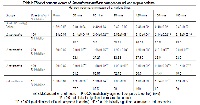Anti-inflammatory and analgesic activities of Jateorhiza macrantha (Menispermaceae)
Keywords:
Jateorhiza macrantha, methanolic extract, analgesic, anti-inflammatory activitiesAbstract
Jateorhiza macrantha (Hook.f.) Exell and Mendonça (Menispermaceae) is a common medicinal plant found in tropical Africa. Jateorhiza macrantha is used as an anti-hemorrhagic, to combat syphilis and headache. This study was performed to evaluate the analgesic and anti-inflammatory activities of its extract. The analgesic activity of the methanolic extract of Jateorhiza macrantha was investigated using the acetic acid (chemical) and tail-clip (mechanical) models of nociception in mice and the anti-inflammatory activity was investigated using the carrageenan-induced paw oedema in rats. In acetic acid-induced writhing test, the extract at doses 100, 200 and 400 mg/kg significantly (P < 0.05, 0.01) reduced the writhing reflex in a dose dependent manner. In the application of the metal artery clip unto the tail of animals, the extract caused a significant (P < 0.05) dose dependent increase in reaction latency with peak effect (7.0%) inhibition produced at the highest dose of 400 mg/kg. In the carrageenan induced paw oedema test, the extract produced a dose dependent significant (P < 0.05, 0.01, 0.001) inhibition of oedema. The results obtained in this study lend credence to the ethnomedicinal use of the plant in the management of pain and inflammatory conditions.
References
. Hideaki Terashima and Mitsuo Ichikawa., (2003): A comparative ethnobotany of the mbuti and efe hunter-gatherers in the ituri forest, Democratic Republic of Congo. African Study Monographs, Journal of Ethnopharmacology; 24(1, 2): 1-168.
. Odugbemi (2008). Outlines and pictures of Medicinal plants from Nigerian 283 pp.
. Jiofack, T., Fokunang, C., Guedje, N., Kemeuze, V., Fongnzossie, E., Nkongmeneck, B.A., Mapongmetsem P.M. and Tsabang, N. (2010): Ethnobotanical uses of medicinal plants of two ethnoecological regions of Cameroon. International Journal of Medicine and Medical Sciences; 2(3): 60-79.
. Thomas Duncan W., Jane McCauley Thomas, Wendy Ann Bromley and Fonki Tobias Mbenkum (1989): Korup ethnobotany survey. The World Wide Fund for Nature report pp. 16 - 27.
. Aboubakar Oumarou B.F., Bella Ndzana M.T., Ngo Lemba Tom E., Bilanda D.C. and Dimo T. (2011). Antihypertensive Activity of Jateorhiza macrantha (Menispermaceae) Aqueous Extract on Ethanol-induced Hypertension in Wistar. International Journal of Pharmacy and Pharmaceutical Sciences; 4(2): 293-298.
. Winter C.A., Risley E.A., and Nuss G.W. (1962): Carrageenan induced oedema in hind paw of the rat as an assay for anti-inflammatory drugs. Pro.Soc. Expt Biol, J.N.Y; 111: 533-547.
. Okpo S.O, Fatokun F. and Adeyemi O.O. (2001): Analgesic and anti-inflammatory activity of Crinum glaucum aqueous extract. Journal of ethnopharmacology. 78: 207-211.
. Bamgbose S.O.A. and Naomesi B.K. (1981): Studies on Cryptolepine: Inhibition of Carrageenan induced oedema by cryptolepine. Planta medica,42: 392-396.
. Singh, S. and Majumbar, D.K. (1995): Analgesic activity of Ocimum sanctum and its possible mechanism of action. International Journal of Pharmacology. 33: 188-192.
. Mbagwu, H.O., Anene, R.A and Adeyemi O.O. (2007): Analgesic, antipyretic and anti-inflammatory properties of Mezoneuron benthamianum Baill (Caesalpiniaceac). Nigerian Quatenary Journal of Hospital Medicine. 17: 35-41.
. Adeyemi, O.O., Okpo, S.O., and Ogunti, O.O. (2002). Analgesic and anti-inflammatory effects of the aqueous extract of leaves of Persea americanamill (Lauraceae). Fitoterapia, 73(5):375-80.
. Di Rosa, M., Giroud. J.P. and Willoughby, D.A., (1971): Studies of the mediators of the acute inflammatory response induced in rats in different sites by carrageenan and turpentine. Journal of pathology; 104: 15-29.
. Nunez Guillen, M.E, Emim, J.A, Souccar, C. and Lapa A.J., (1997): Analgesic and anti-inflammatory activities of the aqueous extract of Plantago major L. International Journal of Pharmacognosy; 2: 112-121.
. Berkenkopf, J.W. and Weichmann, B.M. (1988): Production of prostacyclin in mice following intraperitoneal injection of acetic acid, Phenylbenzoquinone and Zymosin: its role in the writhing response. Prostaglandin. 36:693-709.
. Bentley, G.A., Newton, S.H.and Starr J. (1983): Studies on the antinociceptive action of α-agonist drugs and their interaction with opioid mechanisms. British Journal of Pharmacology, 79:125-134.
. Zakaria, Z.A., Abdul Ghani, Z.D.F., RadenMohd. Nor R.N.S., Gopalan, H.K., SulaimanMolid, R., Mat Jais, A.M., Somchit M.N., Kader, A.A. and Ripin, J., (2008): Antinociceptive, anti-inflammatory, and anti-pyretic properties of an aqueous extract of Dicranopteris linearis leaves in experimental animal models. J.Nat Med; 62(2): 176-187.



